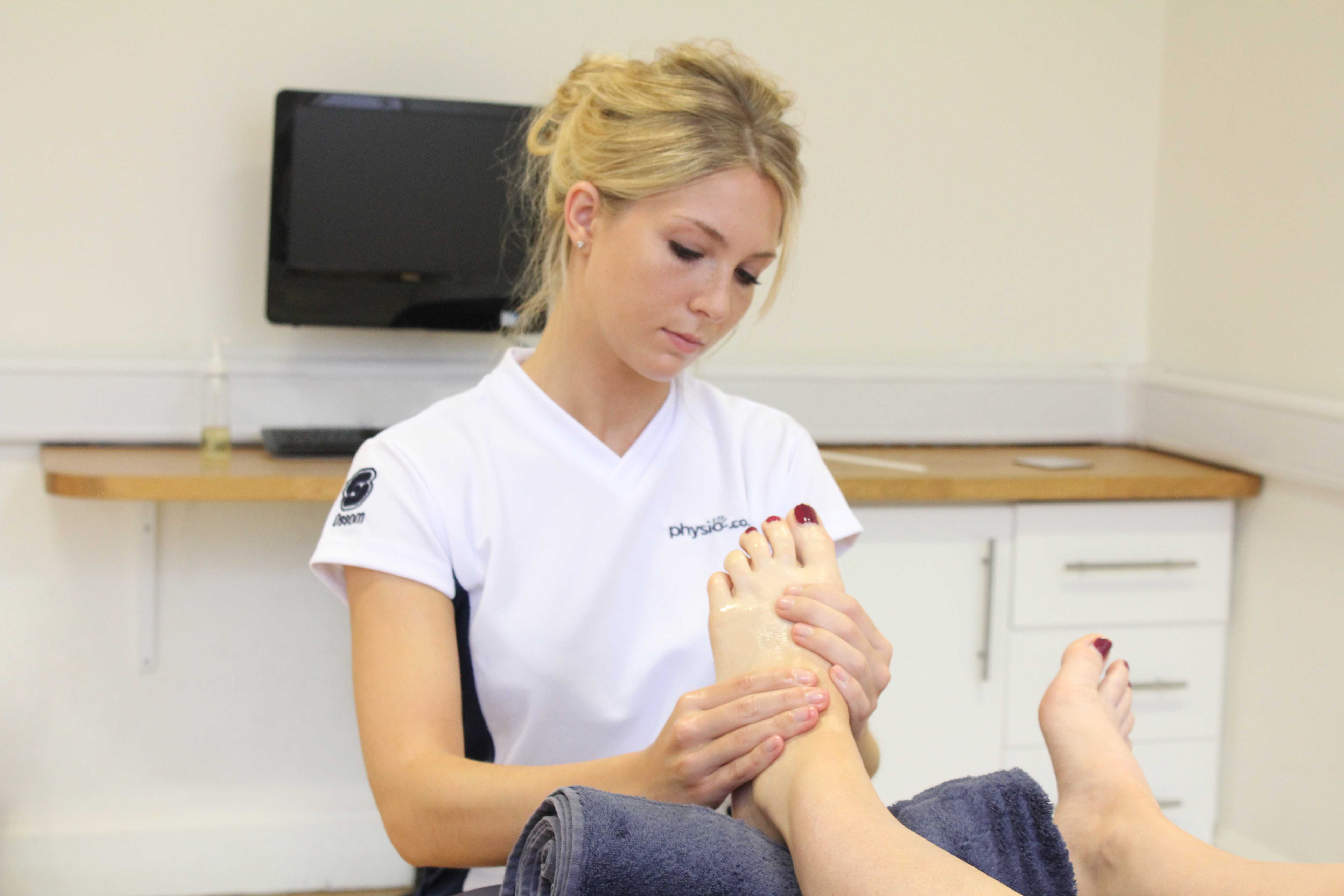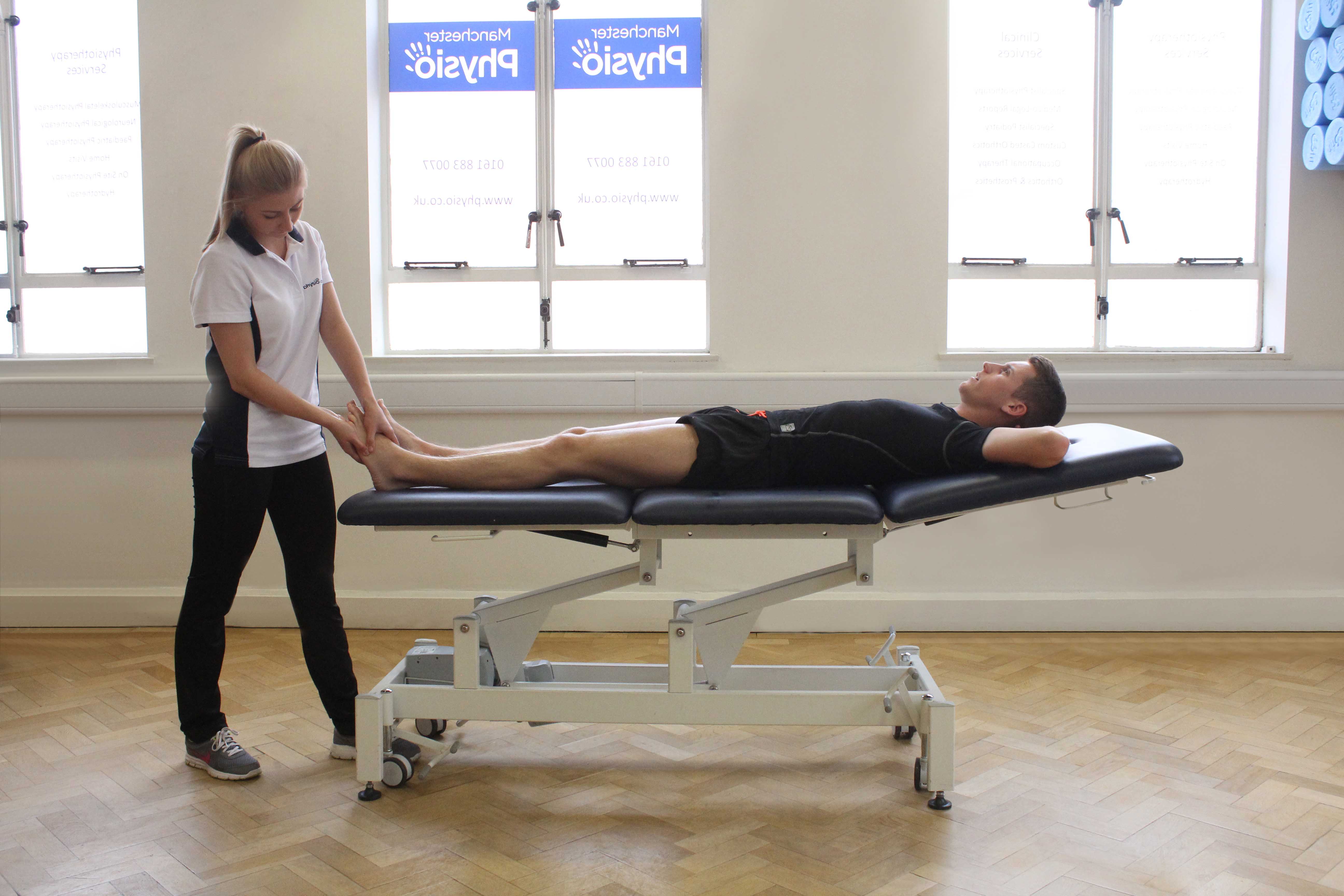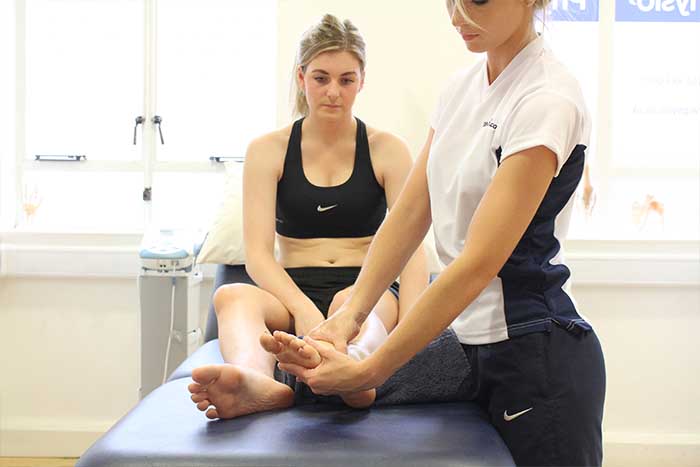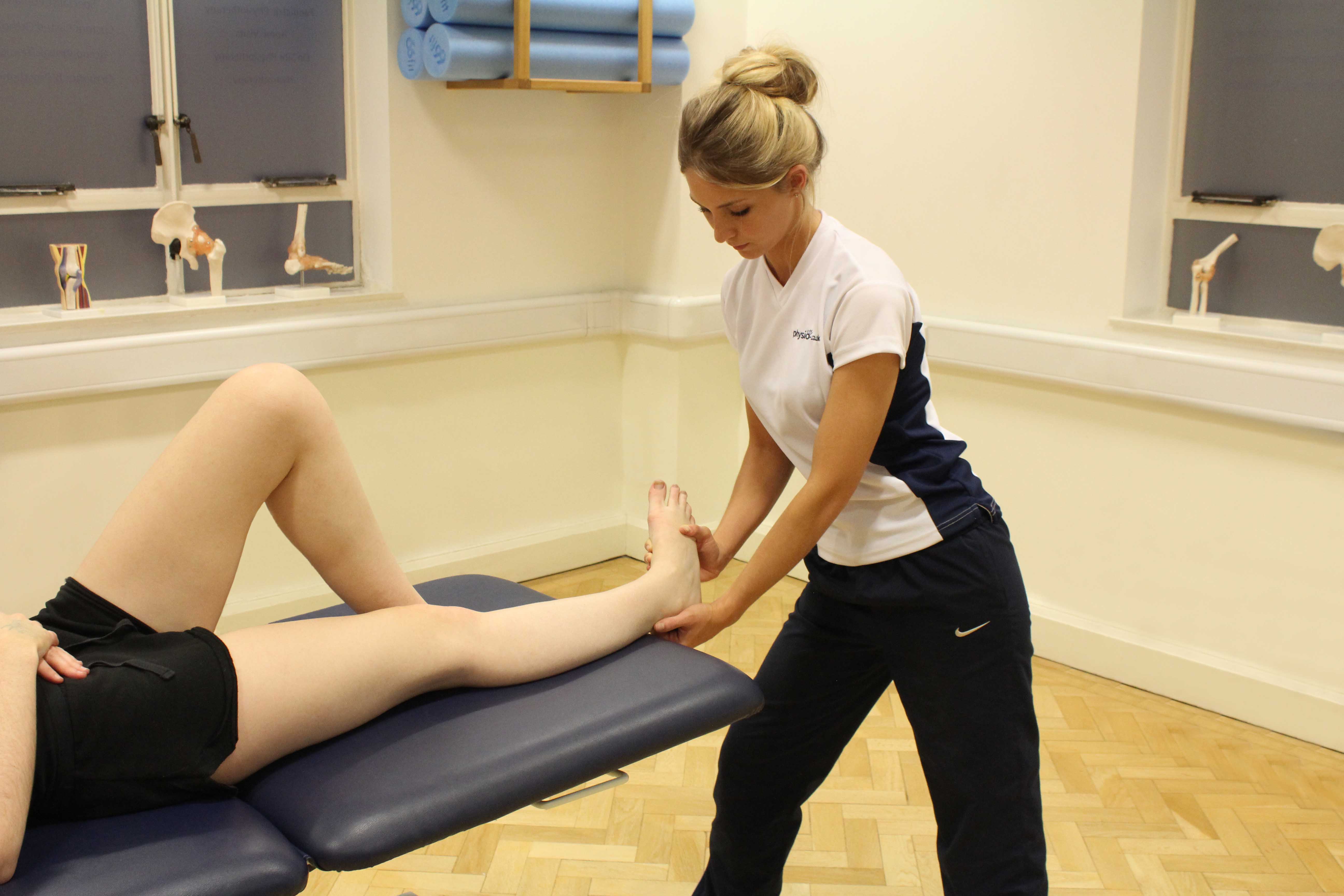A foot massage is focused mainly on the muscles located around the front and back of the feet. There are many muscles located around the feet including; the tibialis anterior, abductor hallucis, extensor hallucis longus, extensor hallucis brevis, dorsal interosseous, extensor digitorum longus and the lumbrical muscles. A foot massage involves a range of techniques, each used to decrease pain, relieve tension and improve circulation. Massage therapists at Physio.co.uk use foot massage to decrease tightness, reduce pain and improve recovery.
What techniques are used in a foot massage?
There are a variety of techniques used during a foot massage. Techniques used within a foot massage include:
 Above: Soft tissue massage of the foot
Above: Soft tissue massage of the footA technique used during a foot massage is acupressure. Acupressure is performed using the fingers and thumbs and involves applying pressure to specific areas of the foot. Acupressure helps break down knots and increase blood flow. When pressure is placed on trigger points or muscular knots, blood flow is restricted causing an ischemic reaction. As pressure is applied, muscular knots are softened and broken down. Breaking down muscular knots reduces pain and restriction in the foot. When pressure is released, an increase in blood flow is encouraged to the muscles. An increase in blood flow helps the muscle to heal as more oxygen and nutrients are delivered.
Frictions can be used during a foot massage. Frictions are performed using the fingertips or thumbs and are when pressure is applied along muscle fibres. Frictions help break down collagen fibres that are built up in muscles. Muscle temperature is increased during a foot massage which helps loosen muscles and break down collagen fibres. Breaking down collagen fibres, increases flexibility of a muscle to therefore reduce restriction.
Skin rolling is an effective technique used during a foot massage. Skin rolling is performed by picking up and rolling the skin between the fingers and thumbs. Skin rolling aims to reduce restriction created by fascia to therefore reduce muscle tightness and pain. Fascia is a tough and fibrous layer of connective tissues found below the skin surface. Fascia can become restrictive resulting in muscle tightness and pain. Restriction is reduced as the temperature of fascia is increased. Increasing the temperature of the fascia allows it to loosen and stretch. Loosening fascia therefore reduces muscle tightness and pain.
Trigger pointing is used during a foot massage. Trigger pointing is where specific pressure is placed on trigger points to help soften and break down muscular knots. Trigger points are found in the middle of a muscle fibre and can cause pain if not treated. Trigger pointing causes an ischemic reaction to occur. An ischemic reaction is when blood flow is restricted due to pressure being placed onto the trigger points. The pressure applied to an area can vary. A person will start to feel a numbing sensation of the area, and when this occurs, pressure is released. An increase in blood flow is encouraged to the area when pressure is no longer being applied, as the body thinks that damage has occurred. An increase in blood flow enables an increase in oxygen and nutrients to be provided to the muscles to reduce fatigue and pain.
 Above: Soft tissue massage of foot, targeting the planta fascia
Above: Soft tissue massage of foot, targeting the planta fasciaWhen can a foot massage help?
A foot massage can help in many different ways. Ways in which a foot massage can help include:

How does a foot massage help acute pain?
Acute pain can be helped through a foot massage. Pain can be due to muscle tightness, overuse or injury. When the body is damaged, receptors in the skin send a signal to the brain. The brain then sends a message to the nerves to create a sense of pain.
A foot massage aims to reduce acute pain by interrupting the signal sent from the receptors to the brain and relieving muscle tightness.
A foot massage is able to interrupt the message sent from the receptors to the brain. During a foot massage, new signals will be sent to the brain due to the friction created between the skin and fingers. A new signal means that the nerves do not receive the message to create pain.
Muscle tightness can be caused by restriction of tissue elasticity. A foot massage reduces restriction and increases tissue elasticity by increasing muscle temperature. Temperature is increased as blood circulation is improved. Increasing temperature of muscle tissues allows them to loosen, stretch and increase in elasticity. Loosening, stretching and increasing elasticity of the tissues reduces muscle tightness and pain.
 Above: Soft tissue massage of the foot
Above: Soft tissue massage of the footHow does a foot massage help post injury?
A foot massage can help post injury. Injuries that most commonly occur include; muscle tears and pulls. Injury can result in muscle tightness and tension that can create pain.
A foot massage aims to decrease effects of injury by improving recovery and decreasing muscle tightness and tension.
Recovery is improved through a foot massage as blood circulation is increased and the lymphatic system is stimulated. When blood circulation is improved, the amount of oxygen and healthy nutrients that are delivered to the muscles is increased. The oxygen and nutrients delivered to the injured muscles, provides them with more energy for healing. Oxygen and nutrients also keep the muscle strong and healthy. The lymphatic system is also stimulated. The lymphatic system removes waste products built up in the muscles after injury more efficiently. When more waste products are removed, swelling and fatigue is reduced. Less waste products also means that there are less damaging products within the muscles.
Muscle tightness and tension is relieved as muscle temperature is increased. Elasticity of muscle tissues can be reduced causing restriction. An increase in temperature reduces the restriction and allows elasticity to increase. An increase in tissue elasticity relieves muscle tightness and tension.

How does a foot massage help post-surgery?
A foot massage can help after surgery. Surgery can leave negative effects on the body. Muscles can become tight and painful due to restriction caused by surgery.
A foot massage aims to reduce muscle tightness and stimulate the lymphatic system to improve recovery post-surgery.
A foot massage helps to relieve muscle tightness and pain. Muscle temperature rises due to the friction created between the fingers and skin. An increase in muscle temperature reduces restriction as inelasticity of tissues is reduced. An increase in tissue elasticity allows the muscles to stretch and move more freely without pain. Reducing restriction and increasing tissue elasticity relieves muscle tightness and pain.
The lymphatic system is stimulated during a foot massage. After surgery, the body becomes more susceptible to infection. The lymphatic helps kill bacteria that create infection. Bacteria is broken down and killed by cells called antibodies. Antibodies are created through the lymphatic system. Stimulation of the lymphatic system therefore reduces effects of surgery. Stimulating the lymphatic system also reduces swelling. After surgery, lymph vessels become blocked resulting in an increase in swelling around the foot and ankle area. Swelling can increase pain and the time taken to heal. Stimulating the lymphatic system helps to unblock the lymph vessels and remove the build-up of waste products more efficiently. Removing the waste products helps to reduce swelling and pain.
 Above: Soft tissue massage of the foot
Above: Soft tissue massage of the footHow does a foot massage help scarring?
A foot massage can help treat scarring. Scars are formed after an injury where skin is damaged. When skin is damaged, scar tissue builds up at the injury site to bring the damaged fibres back together. Scar tissue is made up of fibrous collagen fibres that can become restrictive as it is not as elastic as the skin it has replaced.
A foot massage aims to reduce scarring by loosening and breaking down the scar tissue.
A foot massage can increase the temperature of the scar tissue. Increasing the temperature helps to loosen the scar tissue. When scar tissue is loosened, specific techniques are used to help further break down the scar tissues. After scar tissue has been broken down, different strokes are used to encourage fibres to re align. Re aligning scar tissue can decrease restriction and pain. Re aligning scar tissue can also decrease the appearance of scars and make them less visible.
What are the benefits of a foot massage?
There are a range of benefits gained through a foot massage. Benefits gained through a foot massage include:
How does a foot massage increase healing?
A foot massage can help increase healing. When soft tissues in the foot become damaged, an increase in waste products builds up, further increasing pain and time taken for the injury to heal.
A foot massage aims to increase healing by improving blood circulation and stimulating the lymphatic system.
Blood circulation is improved during a foot massage. Improving blood circulation increases the quantity of oxygen and nutrients given to the injured muscles. An increase in oxygen and nutrients provides the muscles with more energy and makes them stronger and healthier.
The lymphatic system is also stimulated during a foot massage. The lymphatic system is made up of lots of small vessels called lymph vessels. The lymphatic system helps remove the build-up of waste products through the lymph vessels. The removal of waste products and bacteria from muscles makes the muscles healthier and stronger. Increasing strength of muscles and encouraging better health, therefore increases healing.
How does a foot massage reduce swelling?
A foot massage helps reduce swelling. Swelling can be due to many reasons, the most common being trauma and injury.
When the foot becomes injured, an increase in blood flow occurs to the injury site. An increase in blood flow provides the injury with white blood cells, which are used for the repair of damaged tissues and cells as well as oxygen and nutrients. After injury, capillaries in the skin become more permeable. More permeable capillaries means that nutrients, white blood cells and plasma are able to leak out of the capillaries and surround the injury. A build-up of these fluids and other metabolic wastes is what causes swelling. Swelling can be painful and tender to touch if not treated.
A foot massage aims to reduce swelling by removing the excess fluids from the injury site.
As blood and lymph vessels become damaged due to injury, fewer fluids are able to be removed and replaced to the injury site. The body's natural healing process immediately starts to replace damaged vessels. Replacing damaged vessels allows fluids and waste products to be removed from the injury site and more essential healthy nutrients, oxygen and white blood cells to be provided.
How does a foot massage improve circulation?
A foot massage can improve circulation. Poor circulation can result in muscle fatigue and swelling.
A foot massage aims to prevent fatigue and swelling by encouraging capillarisation and vasodilation and increasing cellular exchange.
Capillarisation and vasodilation are increased as muscle temperature rises. Vasodilation is where blood vessels widen and become closer to the skin surface. Blood vessels are able to widen due to the relaxation of muscles lining the walls of the vessels. Widening of blood vessels allows an increase in blood flow to travel through the vessels, therefore improving blood circulation. Capillarisation is the increase of capillaries in specific areas of the body. Increasing capillarisation can provide muscles with an increase in oxygen and nutrients, essential for the maintenance of strong, healthy muscles.
Cellular exchange also increases during a foot massage. Cellular exchange is when an increase in oxygen and nutrients is provided to the muscles and more waste products are removed. Removal of waste products and an increase in oxygen reduces fatigue and decreases swelling due to a build-up of waste products.
How does a foot massage break down scar tissue?
A foot massage helps with the breakdown of scar tissue. After injury, scar tissue is formed as a protective layer. Scar tissue can become restrictive and painful resulting in muscle tightness.
A foot massage aims to break down and loosen scar tissue to reduce muscle tightness and pain.
During a foot massage, the temperature of the muscles rises. A rise in muscle temperature allows elasticity of scar tissue to increase. Increasing the elasticity of the scar tissue reduces restriction. Reducing restriction therefore relieves muscle tightness and reduces pain.
Summary
A foot massage is used on the muscles located around the front and back of the feet. Techniques such as acupressure, frictions, skin rolling and trigger pointing are used to help treat acute pain, post injury, post-surgery and scarring. A foot massage benefits the body by increasing healing, reducing swelling, improving circulation and breaking down scar tissue. Our massage therapists at Physio.co.uk effectively use foot massage to help treat pain, tightness and scarring.
How can I arrange a foot massage?
The easiest way to arrange a foot massage at Physio.co.uk is to email us at office@physio.co.uk or call us on 0800 033 7800.
Alternatively if you have any questions please feel free to contact us.
We offer a 7 day service and provide home and clinic appointments.

 0330 088 7800
0330 088 7800






































